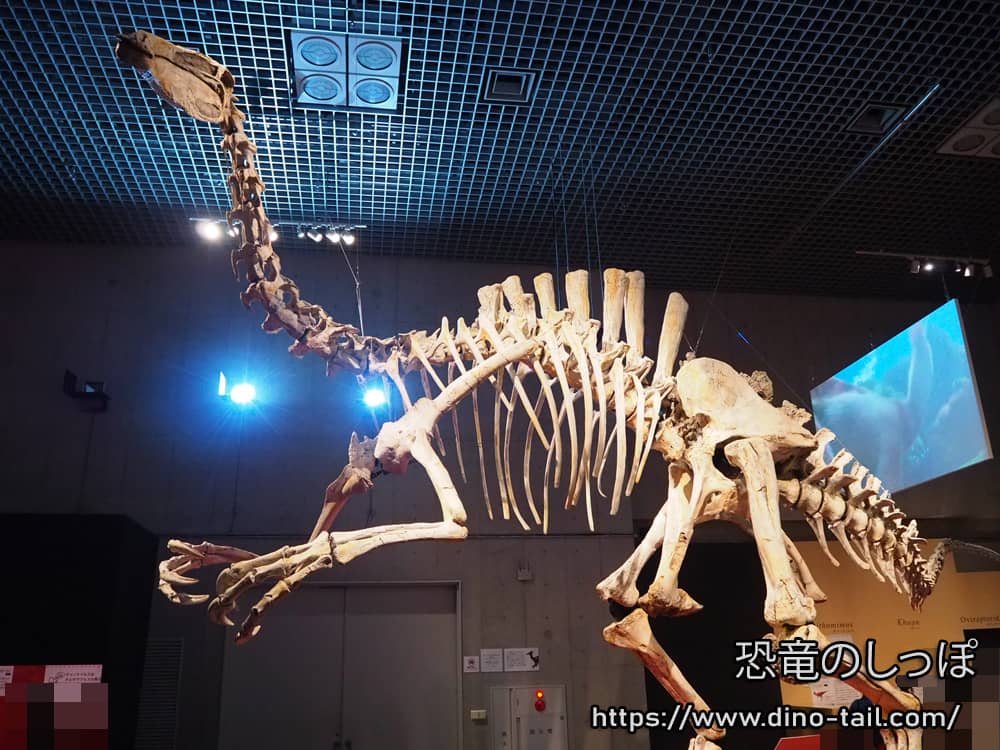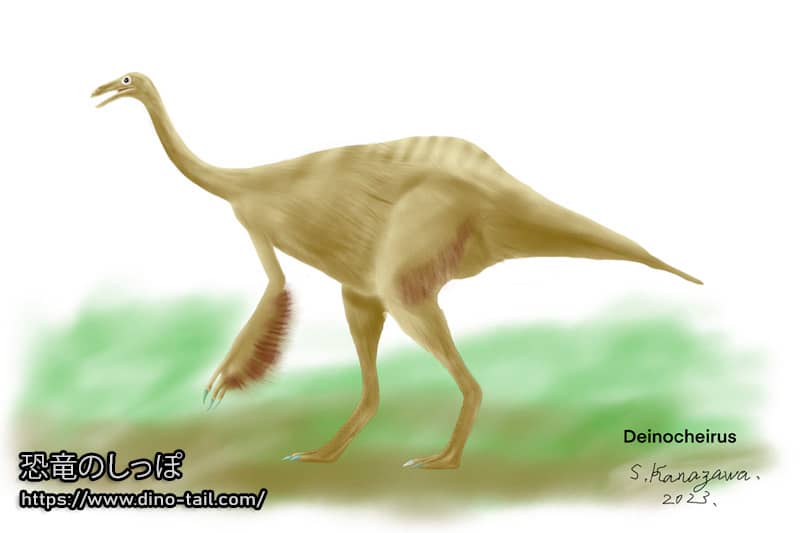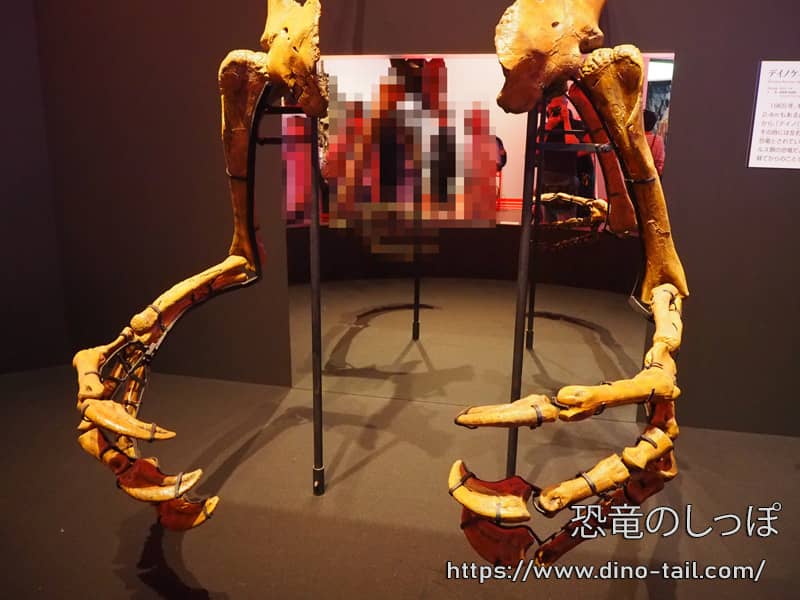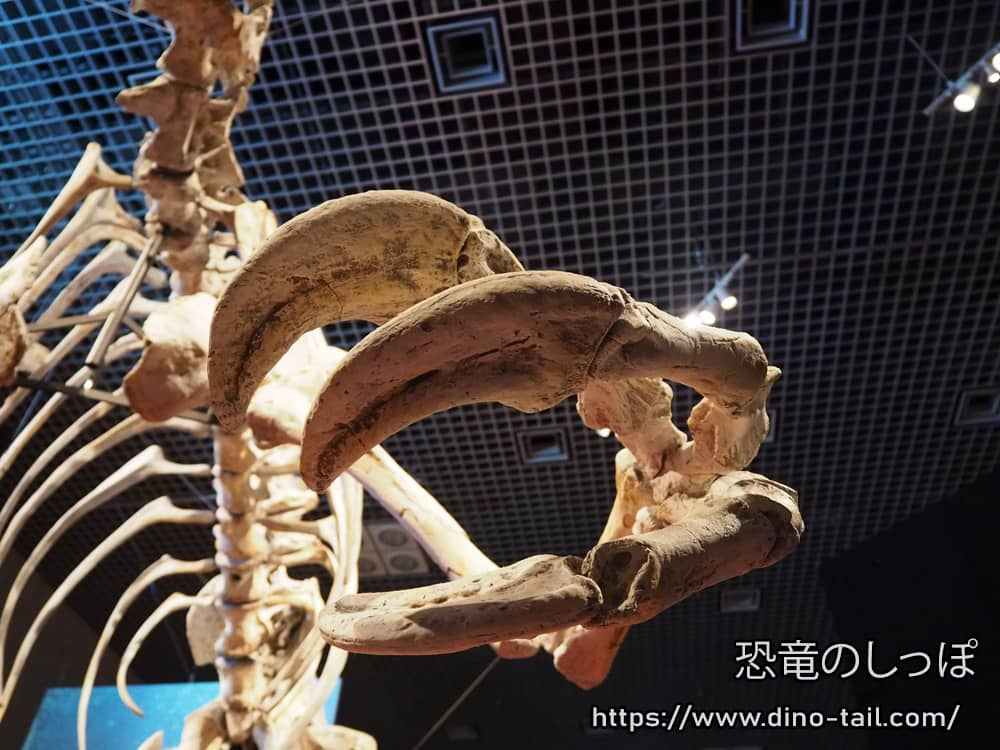About Deinocheirus
| Scientific Name (Genus) | Deinocheirus |
| Meaning of Name |
Terrible hand
deinos (terrible) [Greek] - cheir (hand) [Greek] |
| Classification | Saurischia, Theropoda, Ornithomimosauria |
| Total Length | Approx. 11m (36 ft) |
| Diet | Omnivorous |
| Period | Late Cretaceous (approx. 70 million years ago) |
| Species Name | Deinocheirus mirificus |
| Year of Paper Publication | 1970 |
| Genus Name Publication | Osmólska, H. & Roniewicz, E. (1970). Deinocheiridae, a new family of theropod dinosaurs. Palaeontologia Polonica 21. |
The Identity of the "Terrible Hand" that Solved a Half-Century Mystery
Deinocheirus was a very bizarrely-shaped dinosaur that lived in what is now Mongolia during the Late Cretaceous period. It was a large ornithomimosaur, reaching about 11 meters (36 feet) in length and weighing over 6 tons, making it one of the largest of its kind.

Its most distinctive feature is its enormous arms, which reached up to 2.4 meters (nearly 8 feet) in length and ended in sharp claws, giving it its name. When these arm fossils were first discovered in 1965, their immense size led everyone to imagine a ferocious carnivorous dinosaur. However, for nearly 50 years, no other parts of the skeleton were found, and Deinocheirus remained a "mystery dinosaur," one of the greatest enigmas in paleontology.
In 2014, the results of research on two specimens including the head and torso, discovered in 2006 and 2009, were published, revealing its astonishing complete form. Deinocheirus was entirely different from a carnivore like Tyrannosaurus; it had a high sail on its back, similar to a camel's hump, and a toothless, duck-like beak, giving it a very unique appearance.
It was like a "chimera dinosaur," pieced together from the features of completely different dinosaur groups like hadrosaurs, spinosaurs, and sauropods. Later discoveries and research have shown that it was an omnivorous dinosaur that ate both plants and fish.
It seems the sharp claws of Deinocheirus were not weapons for hunting animals. It is presumed that it used these long, powerful arms like a "rake" to gather plants or pull down high branches when feeding. Also, since it preyed on fish, it's possible the claws were useful for stirring up mud in shallow water or scooping up fish.
Head and Diet: A Toothless Giant Omnivore
The skull of Deinocheirus was long and slender, and surprisingly, it had no teeth at all. The tip of its mouth was broad and flat, resembling the beak of a hadrosaurid (duck-billed dinosaur) like Maiasaura.

The definitive evidence that unlocked its diet was found among its stomach contents. In the area where the stomach of one specimen would have been, more than 1,100 (some sources say 1,400) gastroliths were discovered. Gastroliths are stones swallowed by birds and some herbivorous dinosaurs to help grind up tough plant material for digestion. This discovery suggests that plants were a major part of Deinocheirus's diet.
Along with the gastroliths, fish scales and bones showing clear signs of corrosion from stomach acid were also found. This is direct evidence that Deinocheirus preyed on fish in addition to plants. Combining this evidence leads to the conclusion that Deinocheirus was not the fearsome carnivore initially imagined, but a giant omnivore that ate both plants and fish. Its lifestyle is thought to have been highly adapted to wetland or river environments, where it grazed on vegetation and occasionally caught fish.
Sail on its Back and a Lightweight Skeleton
The vertebrae of Deinocheirus revealed extremely long neural spines, reminiscent of the fish-eating dinosaur Spinosaurus. These spines are believed to have supported a sail covered in skin or a fleshy, camel-like hump. While the sail of Spinosaurus is theorized to have been used for thermoregulation, the sail of Deinocheirus was likely used primarily for display (sexual or social signaling) to other members of its species.
Despite its massive size—11 meters long and an estimated weight of 6.4 tons—the skeleton of Deinocheirus was surprisingly lightweight.
The vertebrae, in particular, had numerous cavities and are thought to have been filled with air sacs (part of an avian-like respiratory system). This feature, known as "pneumatization," was highly developed, comparable to that of sauropod dinosaurs, and served to reduce weight while maintaining bone strength. This skeletal lightening was a key factor that allowed Deinocheirus to achieve a size unmatched by other theropods.
The "Chimeric" Anatomical Features of Deinocheirus
The table below summarizes the features Deinocheirus shared with various dinosaur groups. It visually demonstrates how uniquely this dinosaur evolved.
| Anatomical Part | Deinocheirus's Features | Dinosaur group with similar features | Functional Significance |
|---|---|---|---|
| Skull | Elongated, toothless, with a wide beak |
Hadrosauridae
(e.g., Maiasaura) |
For consuming large amounts of soft vegetation, scooping up aquatic plants and fish |
| Dorsal Vertebrae | Tall neural spines forming a "sail" |
Spinosauridae
(e.g., Spinosaurus) |
Visual display (communication) |
| Vertebrae (internal) | Highly pneumatized (cavities filled with air sacs) |
Sauropods
(e.g., Titanosauria) |
Lightening the skeleton to enable large size |
| Feet (unguals) | Wide, flat, and hoof-like shape |
Hadrosauridae
(e.g., Saurolophus) |
Weight distribution on unstable ground in wetlands (to prevent sinking) |
History of Discovery and Research

In 1965, a joint Polish-Mongolian expedition discovered a pair of giant arms in the Nemegt Formation of the Gobi Desert. This discovery shocked the world, and in 1970, Halszka Osmólska and Ewa Roniewicz named it Deinocheirus mirificus (meaning "unusual, terrible hand") .
However, for a long time, no additional fossils were found. In 2006 and 2009, a joint Korean-Mongolian expedition discovered two partial skeletons, but unfortunately, these specimens had been poached, with their skulls and feet missing.

A breakthrough came in 2011. Fossils owned by a private collector in Europe were identified as the poached skull and feet of Deinocheirus. Through the efforts of researchers, the specimen was returned to Mongolia and combined with the previously discovered torso skeleton, finally allowing for the reconstruction of the entire body of Deinocheirus. This series of events is known as a dramatic episode that highlights the problem of fossil poaching and the importance of international cooperation.
